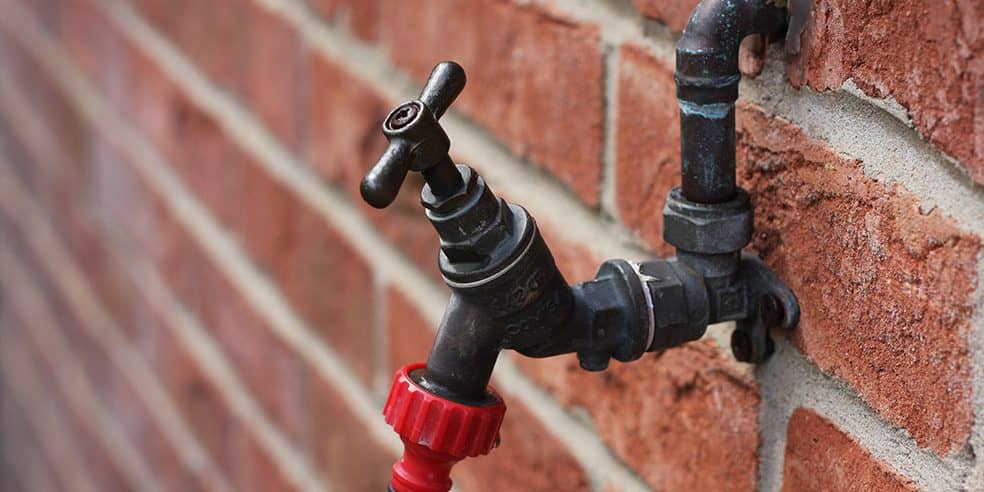If you are pondering the idea of fitting an outside tap for convenient garden watering, washing vehicles and outdoor equipment, cleaning outdoor areas, or even providing water for animals or livestock, we would always recommend consulting with a professional plumber before you start. They can help assess your specific requirements, guide you through the installation process, and ensure that all necessary plumbing connections and precautions are taken to avoid leaks, water wastage, or damage to your property. Better still, why not hire a professional to install the garden tap for you?
No matter what you decide to do, it is worth familiarising yourself with the expert advice in this article given by Oliver Osmore, Director at London plumbing and heating firm Maintracts Services. Oliver shares his answers to the questions which his well experienced team are frequently asked with regards to fitting an outside tap. His knowledge will help you to consider all the factors involved and decide if fitting a tap in your garden is the right option for you and your skill set.
Can you fit an outside tap anywhere?
“Yes, within reason, it is possible to fit an outside tap to anywhere you can get a cold-water supply to. It doesn’t have to be a mains water supply, just a cold-water supply. Plus, an outside tap can be fitted to any property, even if the current pipework is not close to where you are planning to locate your tap. The tap simply needs to be located to somewhere it can be fixed in place and supported adequately. It should be obviously accessible and useable.
It is also important to factor pipe insulation. Dealing with Frozen Pipes is crucial, as the pipework that runs from the cold-water supply to your garden tap will need to be properly insulated using suitable external grade insulation so that it is not at risk of freezing during winter. Depending on where the tap is located, there could be quite a lot of pipework exposed to the elements.
Lastly, there should also be an isolation valve fitted inside the property to where the water supply is being taken from. This allows you to turn off the flow of water to the outside tap during winter to avoid freezing or burst pipes, without needing to turn off your whole house water supply.”

How long does it take a plumber to fit an outside tap?
“The time it takes a plumber to fit an outside tap will depend on the size of the job. For example, if you would like your tap positioned at the other end of your garden - a long way from where your property is, then this will require some extensive pipework and could be 3- or 4-day’s work.
Recently, we installed an outside tap within a communal garden square in central London which serves a number of neighbouring properties. This involved us moulding a pipe from each surrounding property, leading it underneath the road and through into the garden square. It was a massive job which took several days to complete, much like when you need to fix dripping tap issues that require complex plumbing solutions.
However, for a typical domestic property wanting to install a garden tap, it would take our plumbers on average, between 2-5 hours to install.”
Factors to consider when installing the pipework for an outside tap?
“When installing pipework for an outside tap, some key factors to keep in mind are:

Location
Choose a suitable location for the outside tap. It should be easily accessible and close to the area where you need water. The pipework will need to be clipped and well supported. If the tap’s location is somewhere that the pipework connected to it will not be adequately supported and clipped, it could hazardous. Factors like convenience, aesthetics, and proximity to existing plumbing lines are important too.
Water source
Determine the source of the water for the outside tap. It could be connected to the mains water supply or another cold-water source such as a rainwater harvesting system. Ensure that the water source is readily available and has sufficient pressure to meet your needs.


Frost protection
It is crucial to protect the pipework from freezing and potential damage. Use appropriate insulation material, such as pipe sleeves, to prevent freezing during colder months.
Pipe material
Select the right type of pipe material for the installation. Common options include copper and PVC. Consider factors like durability, cost, ease of installation, and compatibility with your existing plumbing system.


Pipe diameter
Determine the appropriate pipe diameter based on the water flow requirements. Consider the intended use of the tap, such as watering plants or filling bucket, and ensure the pipe diameter can manage the desired flow rate.
Connection to existing plumbing
If you are connecting the outside tap to an existing water supply, consider the location of the nearest water source and the feasibility of connecting the pipework. Determine whether you need to extend the existing plumbing or install a separate branch line.


Digging and trenching
Plan the route for the pipework and consider any digging or trenching required. Ensure that the trench is deep enough to protect the pipe and comply with local building codes. Take into account any potential obstructions, such as utilities or landscaping features.
Isolation valve
Install an isolation valve inside the property to where the water supply is being taken from to install easy access for turning off the water supply to the tap. This is important for maintenance, repairs, or periods when the tap is not in use.”

How much would it cost to fit an outside tap?
“A straightforward outside tap installation typically costs between £200 to 250 pounds +VAT. However, it will depend on the size of the job, the amount of pipework required, and the ease of accessibility.”
Will the pipes freeze/ burst in winter?
“As I mentioned earlier on, to prevent outside tap pipes from freezing during winter, there are a few steps you can take, including insulating the pipes with foam sleeves to retain heat, and shutting off the water supply, draining the pipes, and insulating the tap itself when not in use. Additionally, it’s essential to follow a step-by-step guide to clearing outside drain fat blockages to ensure proper drainage. Regular plumbing maintenance and repair and monitoring are important to minimise the risk of freezing.”
OLIVER’S TOP TIP
“During winter, turn the isolation valve off inside the property and open up the outside tap. This allows any water trapped in the pipework to run out and ensures there is no water trapped in the pipework between the valve and garden tap.
If you simply isolate the water supply in the property without opening up the outside tap, the pipework between the valve and the garden tap remains filled with water over the winter. If any of that section of pipework isn’t insulated, then the pipe could freeze. When water freezes, it expands, causing a possible pipe rupture. This could cause a leak inside or outside between those two points.
It is particularly important to take these steps if your tap is located a long way from the water supply connection. For example, in a top-floor maisonette, the pipework will likely need to come all the way down/across the property’s exterior. That is a long section that is more likely to freeze in winter if there is water trapped inside.”
How to fit an outside tap
“Once you have considered all the factors listed earlier, you can progress with installation. Here is an overview of the six steps involved in fitting an outside tap:
1
Establish the location of the tap.
2
Identify the closest water source inside the property to the tap’s location, but it doesn’t need to be inside the property, just the closest water source to the tap.
3
Isolate the water supply and create a new connection with a suitable isolation valve.
4
Extend a new pipe from that point to the position of the new tap, drilling a hole through any walls where necessary, sleeving the pipe, and closing the opening through the wall afterwards.
5
Connect up the outside tap and insulate all of the external pipework using suitable external grade insulation. Clip and support the pipework where necessary.
6
Purge and test the tap’s function too check it is in full working order upon completion.
If you’re uncertain about any aspect of the installation or if it involves complex plumbing work, I will always advise seeking professional assistance from a licensed plumber. They can ensure a safe and compliant installation.”
Domestic installations can sometimes seem straightforward, but if you are not confident with plumbing projects, they can quickly feel complex. It is always worth giving a professional a call. After all, water leaks and burst pipes can be very damaging and costly, not to mention a great waste of water. The Maintracts team are here for you if you need them.

